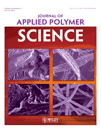Influence of cocatalyst on the structure and properties of polypropylene/poly (ethylene-co-propylene) in-reactor alloys prepared by MgCl2/TiCl4/diester type Ziegler-Natta catalyst
Abstract
In this work, a series of polypropylene/poly(ethylene-co-propylene) (iPP/EPR) in-reactor alloys were prepared by MgCl2/TiCl4/diester type Ziegler-Natta catalyst with triethylaluminium/triisobutylaluminium (TEA/TIBA) mixture as cocatalyst. The influence of cocatalyst and external electron donor, e.g., diphenyldimethoxysilane (DDS) or dicyclopentyldimethoxysilane (D-donor), on the structure and mechanical properties of iPP/EPR in-reactor alloys were studied and discussed. According to the characterization results, PP/EPR was mainly composed of random poly(ethylene-co-propylene), segmented poly(ethylene-co-propylene), and high isotactic PP. Using TEA/TIBA mixture as cocatalyst and DDS as external electron donor, as TEA/TIBA ratio increased, the impact strength of iPP/EPR in-reactor alloys had an increasing trend. Using TEA/TIBA mixture as cocatalyst and D-donor as external electron donor, the impact strength of iPP/EPR in-reactor alloy were dramatically improved. In this case, the iPP/EPR in-reactor alloy prepared at TEA: TIBA = 4 : 1 was the toughest. The influence of cocatalyst and external electron donor on the flexural modulus and flexural strength could be ignored. © 2011 Wiley Periodicals, Inc. J Appl Polym Sci, 2011




